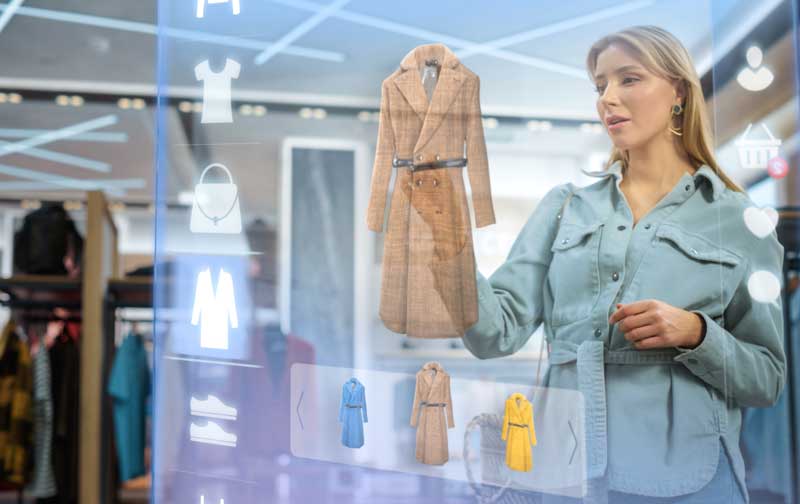
In the retail sector, the digitalization of points of sale has become a strategic imperative to remain competitive and meet the expectations of increasingly connected and demanding customers. This digital transformation offers numerous opportunities to enhance the customer experience, optimize operations and stimulate retail growth.
This white paper explores in depth the processes, benefits and success stories of digitalizing retail outlets.
The retail landscape has undergone rapid change in recent years, fueled by the rise of e-commerce and the massive adoption of digital technologies by consumers. According to a Fevad study, in 2021, e-commerce will account for 14.1% of retail sales in France, up from 15.1% in 2020. This trend has accelerated the need for retailers to adapt their strategies and integrate digital solutions into their physical outlets.
What’s more, today’s consumers are more connected and demanding than ever. They are looking for personalized, seamless and omnichannel shopping experiences. According to a Salesforce survey, 76% of French consumers say that a service’s experience is as important as its products and services. The digitization of points of sale enables retailers to meet these expectations by offering more engaging and convenient purchasing paths.
Point-of-sale digitalization involves integrating innovative digital technologies into physical stores to enhance the customer experience, optimize operations and boost sales. Deploying the Internet of Things to track stock in real time, Artificial Intelligence to help personalize offers, or Augmented Reality to enable virtual product fitting are the most prominent examples.
Digital checkouts, click & collect, interactive kiosks, etc. are other examples of modernization, perhaps more telling to all.
The emergence of new technologies has been a major catalyst in the digitalization of retail outlets. Among the most striking innovations are the following.
The IoT makes it possible to connect and track a variety of in-store objects and equipment in real time, offering greater visibility over inventory, customer flows and operational performance. According to a Gartner study, 87% of Retailers plan to use IoT by 2021 to radically rethink their operational models.
AI and advanced analytics can harness customer and operational data to gain valuable insights and personalize the buying experience. According to Capgemini, 28% of organizations are already using AI for data analysis and decision-making.
AR and VR offer customers immersive, interactive experiences, facilitating virtual product try-ons or 3D visualization. According to a Gartner study, 100 million consumers will buy products in AR by 2022.
Digital shelf marking consists of equipping shelves with sensors and electronic tags to monitor stock levels and product location in real time. Coupled with data analysis, this enables optimized shelf management and targeted promotions for customers.
In-store interactive kiosks give customers convenient access to a wide range of services, such as quick product searches, detailed product information, availability and click & collect reservations. They facilitate discovery and considerably enhance the shopping experience.
Equipped with connected tablets, sales staff can access all product information, consult stock levels in real time, and even place orders for customers. An invaluable tool for personalized service and efficient, comfortable assisted sales for the customer.
Customers can order online and collect their purchases in-store or from a dedicated area, thanks to click & collect and Drive. It’s a fast, convenient solution that streamlines the multi-channel shopping experience. These 2 major innovations are also a perfect solution for customers in a hurry.
The new digital cash registers integrate multiple functionalities such as contactless payment, product recognition and the suggestion of complementary sales effectively targeted to increase the average basket.
More and more stores are offering “hotspots” where customers can take photos or videos and share them instantly on social networks, creating viral content and considerably increased visibility for the retailer.
Many retailers have already successfully embarked on their digital transformation at the point of sale. Here are just a few examples.
Sephora has deployed “Smart Mirrors” in its stores, enabling customers to virtually try on make-up products thanks to augmented reality. This innovative experience helped increase conversion rates and average shopping baskets by 11.5%.
Nike has launched the “Nike Live” concept, which uses data analysis to adapt product assortment and layout to local customer preferences in real time. This approach has increased sales by 7% in pilot stores.
Leroy Merlin has set up “Boutiques Digitales” equipped with interactive terminals, touch screens and augmented reality to facilitate the discovery of products and services. This initiative has considerably improved customer experience and satisfaction.
Digital technologies make it possible to completely rethink the shopping experience, making it more fluid, personalized and memorable, thanks to tools such as augmented reality for virtual product trials, or artificial intelligence for tailor-made recommendations.
By offering innovative and differentiating experiences, digitalized stores can attract new customers who are curious to discover these new services, and thus boost in-store traffic.
The Internet of Things and real-time data analysis can be used to optimize inventory management, customer flow, scheduling and store layout for greater operational efficiency.
Redesigned shopping paths, increased personalization and immersive experiences encourage impulse buying and significantly increase the average customer basket.
By integrating the latest technological innovations, retailers can sustainably differentiate themselves from their competitors by offering unique, more memorable services.
As customers become increasingly demanding, digitalization enables us to meet their expectations for a modern, fast and customized experience. It is therefore a key factor in long-term customer loyalty.
Deploying cutting-edge technologies such as Artificial Intelligence, Augmented Reality or the Internet of Things represents a fairly substantial initial investment cost for retail managers.
To take full advantage of the new digital tools, it is essential to train all store teams, which requires dedicated resources and a dedicated budget. Indeed, a new technology that is poorly used will not bring the expected benefits.
With the collection and use of customer data, it is essential to comply with current (and sometimes restrictive) regulations and to implement robust cybersecurity measures, which can be a source of stress for retailers.
Some customers or employees may initially be resistant to these new digital experiences, hence the importance of appropriate communication and support from an expert company to provide personalized training, facilitate adoption and gradually change mentalities.
The main aim of digitalizing points of sale is to enable retailers to meet consumers’ new expectations in terms of shopping experience, while optimizing their operations (and costs) and stimulating growth. By integrating innovative technologies, retailers have the opportunity to set themselves apart from the competition and strengthen their competitiveness over the long term.
Digitizing customer relations means taking advantage of digital technologies to offer consumers a personalized, omnichannel shopping experience. This involves harnessing customer data to better understand their preferences, as well as deploying in-store digital tools (interactive terminals, augmented reality, etc.) to make the purchasing journey more engaging and convenient. The aim is to create a special relationship with the customer, offering tailor-made service and memorable experiences.
To successfully digitalize their points of sale, retailers need to adopt a strategic, holistic approach, taking into account several key elements.
It is essential to define a clear vision of the desired digital transformation, aligning it with business objectives and customer expectations. This vision must be shared and supported by all the teams concerned.
Before deploying digital solutions, it’s crucial to map and analyze the customer’s current shopping journey in depth, in order to identify friction points and opportunities for improvement.
Digitizing points of sale is an ongoing process that requires an agile, iterative approach. We recommend starting with pilot projects, analyzing results and making adjustments before rolling out on a larger scale.
The success of digital transformation depends to a large extent on the involvement and training of store teams. It’s essential to involve them from the very start of the process, and provide them with the skills they need to take advantage of the new technologies.
With the integration of digital solutions, customer data management and privacy protection become crucial issues. Retailers must implement robust security measures and comply with current regulations.
The digitalization of sales outlets is an unavoidable trend in the retail sector. By leveraging emerging technologies and rethinking the customer experience, retailers can differentiate themselves, build customer loyalty and drive growth. However, this transformation requires a strategic approach and solid expertise to meet the technical, operational and cultural challenges.
It is in this context that Inibar, with its recognized expertise in IT support for businesses, is positioned as the partner of choice for retailers wishing to successfully complete their digitalization project. Thanks to its team of certified experts and its experience in implementing innovative digital solutions, Inibar can guide them through every stage of their transformation, from strategy definition to team training and secure technology integration.
In the future, point-of-sale digitalization will continue to evolve, driven by the emergence of new technologies such as metavers, blockchain and widespread artificial intelligence. Retailers who know how to constantly adapt and innovate will be best positioned to take advantage of these developments and offer ever more immersive and personalized shopping experiences.
For over 25 years, Inibar has been supporting retail chains at every stage of their digital transformation, helping them to meet the challenges of digitalizing their outlets.
Thanks to its recognized expertise in deploying innovative technological solutions and its in-depth knowledge of the market, its teams can offer you tailor-made support to help you achieve your objectives, including:
With a proven track record of success with major retailers, Inibar’s certified consultants will guide you through your digitalization journey. Together, they will help you rethink the in-store customer experience, enabling you to achieve your long-term growth and competitiveness objectives.
Fevad, Key figures 2021
Salesforce, State of the customer experience 2022
Gartner, IoT Forecasts for Retail 2021
Capgemini, Report on AI in Retail 2022
Gartner,Retail AR Forecast 2022
Sephora, Case study “Smart Mirrors” 2021
Nike, Case study “Nike Live” 2022
Leroy Merlin, Press release “Boutiques Digitales” 2021
In the retail sector, the digitalization of points of sale has become a strategic imperative to remain competitive and meet the expectations of increasingly connected and demanding customers.

